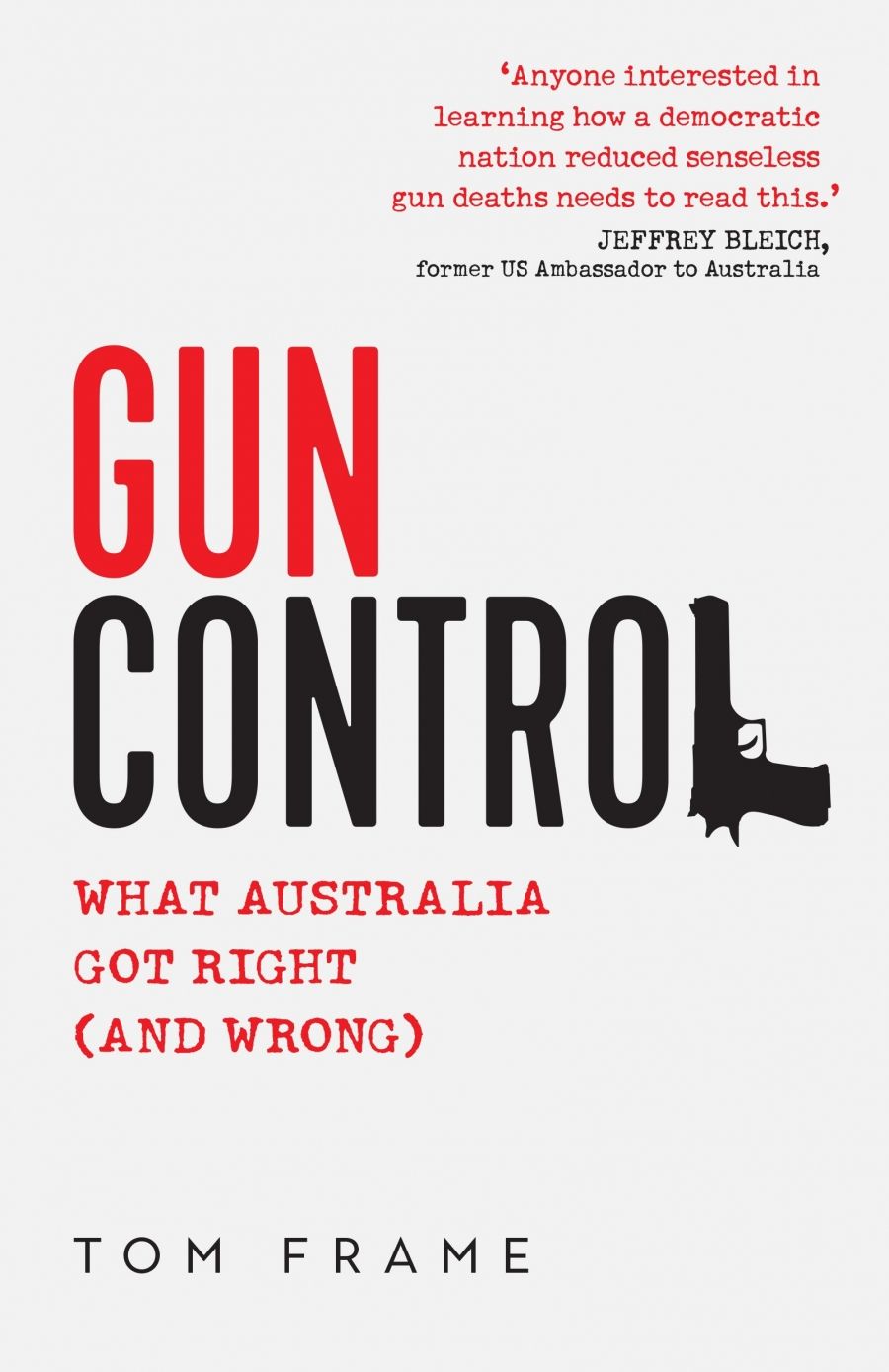
- Free Article: No
- Contents Category: Politics
- Review Article: Yes
- Custom Highlight Text:
This is an unusual book. It is, so the title indicates, about guns and firearm regulations in Australia, with some comparison to the United States. But, as a prefatory note to readers cautions, ‘this book is less about guns and more about the continuing tension between the authority and power of the state and the responsibilities and entitlements of citizens ...
- Featured Image (400px * 250px):

- Book 1 Title: Gun Control
- Book 1 Subtitle: What Australia got right (and wrong)
- Book 1 Biblio: UNSW Press, $34.99 pb, 240 pp, 9781742236346
Despite extensive consideration domestically and abroad of the most effective way to regulate firearms, the discussion has been unproductive and characterised by polarity. ‘The inability to talk sensibly and constructively about reviewing and reforming firearm legislation is perhaps the most lamentable outcome of the Australian experience,’ Frame writes. To address this lacuna, the author seeks to offer a sophisticated analysis that navigates a nuanced middle ground. ‘This is a complex debate … [It] cannot be reduced to simple slogans and sound bites,’ he continues. ‘I have tried to avoid them in what follows.’ Frame largely succeeds, an impressive feat given the high emotions, bitter divisions, and political complexities prevailing in this context.
The shadow of the 1996 Port Arthur massacre looms large throughout this book and in any discussion of gun control in Australia. A direct line can be drawn from Martin Bryant’s mass murder of thirty-five people to the National Firearms Agreement (NFA), ‘a watershed in Australia public life’, which imposed stringent limitations on gun usage via a political compact between the federal, state, and territory governments. Much of Gun Control is a careful history of the political and regulatory reaction to the 1996 shootings. Then-Prime Minister John Howard and Nationals Leader Tim Fischer feature heavily – two central characters in the creation of the NFA, which the former cites among his major achievements.
 An Australian Federal Police officer explains to TODAY presenter Liz Hayes the characteristics of various weapons as part of the media coverage of the Australian Police Ministers Council meeting on 10 May 1996 (photograph via the Australian Federal Police Museum, AFPM10184)
An Australian Federal Police officer explains to TODAY presenter Liz Hayes the characteristics of various weapons as part of the media coverage of the Australian Police Ministers Council meeting on 10 May 1996 (photograph via the Australian Federal Police Museum, AFPM10184)
More than two decades of perspective enable Frame to analyse the successes and failures of the NFA. He summarises numerous data-rich studies on the link between the regulatory regime and gun-crime trends. That research is ultimately inconclusive. Some contend that the absence of a mass shooting since Port Arthur is proof enough of success, although definitional disagreement about what constitutes a ‘mass’ shooting and the inability to prove causation leave such claims open to challenge. Gun-related violent crime and suicides have decreased since 1996, although, again, the NFA’s influence is not certain. Frame does not dismiss the scheme, but his nuanced appraisal is a reminder, in the words of one quoted researcher, of the need to avoid ‘myopic pride in our gun laws’ and to apply ‘intellectual honesty’ in determining the NFA’s efficacy.
Two primary criticisms can be levelled at Gun Control. First, it lacks a strong narrative arc and feels at times disjointed. The author begins with an introduction, note to readers, and glossary before his first substantive chapter covers the political context at the time of Port Arthur. The book repeatedly returns to 1996 and its aftermath, while the ensuing chapters consider more recent developments, delve back into history, and venture across the Pacific to the US experience. Although the macro structure is broadly chronological, from Port Arthur to present, the frequent temporal and geographical jumps can be disconcerting.
Secondly, too little of the book is directed towards practical suggestions for regulatory reform. Frame takes a long run-up at the position that ‘the case for amending the NFA is compelling’. He argues that the agreement ‘is neither immutable nor infallible’, pointing to numerous deficiencies in design and implementation. Considering the NFA above revision, he posits, would be ‘a form of legislative idolatry.’ Frame’s case is convincing, but his subsequent guidance is limited – a section entitled ‘How should the NFA be revised?’ runs to just five pages.
In a subsequent chapter, Frame points to road rules as a successful example of cooperative federal–state standardisation, notwithstanding ongoing flux. Beyond this and a handful of narrow criticisms of distinct aspects of the NFA, there is little persuasive insight as to how exactly Australia should strike the appropriate ‘balance between state authority and individual liberty’ in this arena. A manual for reform may not have been Frame’s intention, but it feels like a missed opportunity nonetheless.
These minor critiques do not detract from what is an impressive, articulate, and much-needed reflection on a topic of upmost public importance. Frame concludes by insisting that ‘the NFA cannot be the “last word” in the way firearms are regulated in Australia’. He calls for ‘the whole community to engage in discussion about firearms’, a debate informed by ‘facts rather than fears’. This plea is laudable. There are, though, few indications that Australia’s fractious, post-truth political landscape can sustain such an informed discussion at present. To the extent it can, Frame’s Gun Control is an excellent primer. One can only hope that it does not take another Port Arthur for his suggestion to be heeded.


Comments powered by CComment